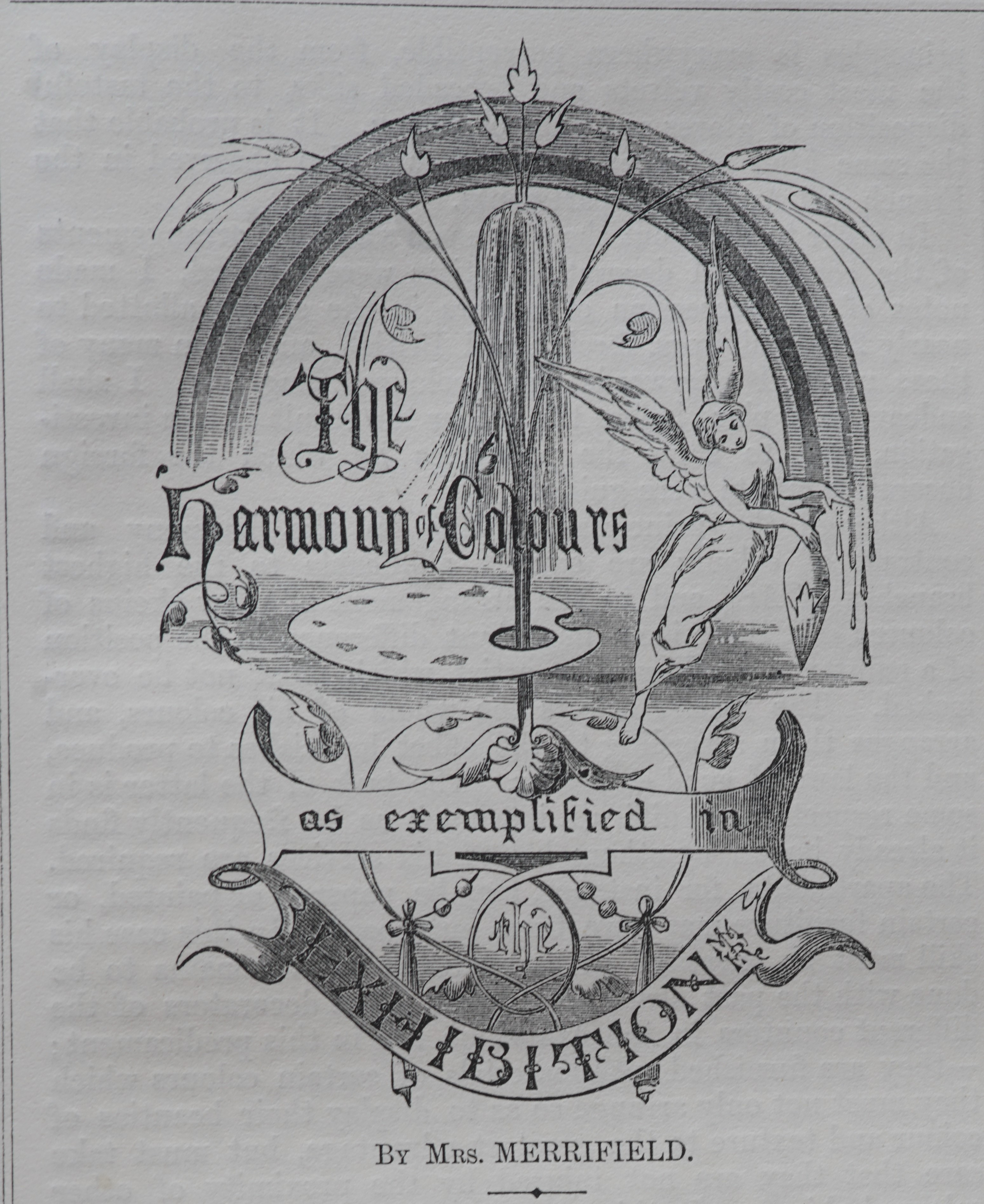
Mary Philadelphia Merrifield and the Great Exhibition of 1851
Colour Pedagogy
1851
Until well into the twentieth century few women published on colour. Mary Philadelphia Merrifield (1804–1889) is an early example of a woman writing and publishing in the field and left a significant mark on colour research and literature in the nineteenth century. She is best known for the first English translation of Cennino Cennini’s Libro dell’arte (A Treatise on Painting, Written by Cennino Cennini in the Year 1437), published in London in 1844. In it she refers to George Field and praises the high quality and permanence of his pigments. We also know that she studied other works on colour meticulously, for example John Burnet’s series on aspects of painting, first published in the 1820s. A copy of Burnet’s Practical Hints on Colour in Painting (1828 edition) that belonged to Merrifield is now in the library of the Yale Center for British Art and carries extensive pencil notes by her.
Following the success of her translation Merrifield was in 1844 commissioned by Prime Minister Robert Peel's government to travel to France and Italy, in the company of her young son Charles, in order to identify and transcribe medieval and Renaissance manuscripts on colour, and research the make-up of early pigments and Italian methods of painting. The trip resulted in several important publications that highlight the importance of texts as historical documents, including Original Treatises, Dating from the XIIth to XVIIIth Centuries on the Arts of Painting (2 volumes, London, 1849).
Although Merrifield is best known for recording, transcribing, and translating historical colour literature, she also wrote about the application of colour theory in art and architecture. In 1851 she provided a critical essay about Owen Jones’s colour scheme for the interior of Joseph Paxton’s Crystal Palace, the site of the Great Exhibition. The essay was included in the accompanying Illustrated Catalogue, published by The Art Journal. Merrifield gave this the title ‘The Harmony of Colours as Exemplified in the Exhibition’, clearly responding to ideas about colour and colour arrangement developed a generation earlier. Her essay is peppered with references to Michel Eugène Chevreul’s De la loi du contraste simultané des couleurs [The Laws of Simultaneous Contrast of Colour], which had been published in 1839. Merrifield, who taught herself multiple languages, must have read Chevreul in French, since the first English translation did not appear until 1854. In the essay she also explains Jones’s colour scheme and touches upon ways in which shapes and objects in interior design influence the use of color and choice of pigments. She concludes that the same principles apply to painting a picture, designing an interior, or decorative objects: ‘The attainment of a good and harmonious style of colour in painting is the result-of much observation and study, not only of nature, but of the works of other artists: the same steps must be followed in Art-manufactures, or the same results will not be attained. When the principles by which the harmony of colour is regulated are clearly understood, they are easily carried into practice.’
From the early 1850s onwards, Merrifield authored several guidebooks with practical advice on painting and drawing, in a series of artists’ handbooks published by Winsor & Newton. In these guidebooks she condensed her substantial knowledge of many aspects of colour, which she largely accumulated through self-study and observation. These books went into many editions and were still being reissued by Winsor & Newton after her death. In 1854, she also published a remarkable book on dress history, Dress as a Fine Art, one of the first of its kind, in which she makes remarks on colour in fashion, and highlights the effects of corsets on women’s bodies. Later, the interests of marvelous Mrs Merrifield shifted to the field of natural history, and she published a book entitled A Sketch of the Natural History of Brighton (1860).
Bibliography
-
Burnet, John, Practical Hints on Colour in Painting, 1828.
-
Chevreul, Michel Eugène, De la loi du contraste simultané des couleurs, Paris, Pitois-Levrault & Co, 1839. https://archive.org/details/delaloiducontras00chev/mode/2uphttps://archive.org/details/lawscontrastcol00chevgoog/mode/2up
-
Merrifield, Mary Philadelphia, The Art of Fresco Painting, as Practised by the Old Italian and Spanish Masters, with a Preliminary Inquiry into the Nature of the Colours Used in Fresco Painting, with Observations and Notes, London: Printed for the Author, by Charles Gilpin, 5 Bishopsgate Street and Arthur Wallis, Brighton, 1846. https://archive.org/details/artfrescopainti00merrgoog/mode/2up
-
Merrifield, Mary Philadelphia, Original Treatises: Dating from the XIIth to XVIIIth centuries on the arts of painting, in oil, miniature, mosaic, and on glass; of gilding, dyeing, and the preparation of colours and artificial gems; preceded by a general introduction; with translations, prefaces, and notes, 2 vols, London: John Murray, 1849. https://archive.org/details/originaltreatis00merrgooghttps://archive.org/details/originaltreatis01merrgoog
-
Merrifield, Mary Philadelphia, Practical Directions for Portrait Painting in Water-Colours, London: Winsor & Newton, 1851. https://archive.org/details/practicaldirect00merrgoog/mode/2up
-
Merrifield, Mary Philadelphia, Dress as a Fine Art, London: Arthur Hall, Virtue & Co., 1854.
-
Merrifield, Mary Philadelphia, A Sketch of the Natural History of Brighton and its Vicinity, Brighton: W. Pearce, 1860.
-
Merrifield, Mary Philadelphia, ‘The Harmony of Colors as Exemplified in the Exhibition’, The Art Journal Illustrated Catalogue: The Industry of All Nations, London: Published for the proprietors, by George Virtue, 1851, I-VIII.
-
Cennino Cennini (author), Mary Philadelphia Merrifield (translator), Guiseppe Tambroni (introduction and notes), A Treatise on Painting, Written by Cennino Cennini in the Year 1437; and First Published in Italian in 1821 […], London: Edward Lumley, 1844. https://archive.org/details/atreatiseonpain00merrgoog/mode/2up